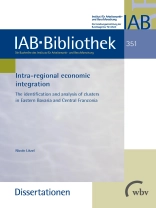Die Wettbewerbsfähigkeit von Betrieben hängt aufgrund ihrer möglichen Einbettung in die regionalen Wirtschaftsstrukturen auch von den lokalen Bedingungen ab. Deswegen stehen Wirtschaftscluster bereits seit geraumer Zeit im Fokus der regionalökonomischen Forschung und der regionalen Wirtschaftspolitik.
Wie können regionale Cluster identifiziert werden? Welche Rolle spielen Cluster im internationalen Standortwettbewerb? Von welchen Faktoren hängt die Kooperation zwischen Betrieben innerhalb eines Clusters ab? Und welche Auswirkungen auf Überlebenswahrscheinlichkeit und Beschäftigtenwachstum hat es, wenn sich Betriebe in Clustern positionieren?
Diesen und anderen Fragen geht Nicole Litzel – gestützt auf Daten aus dem regionalen Informationssystem CORIS – am Beispiel der Wirtschaftsregionen Nürnberg und Ostbayern nach.
Cuprins
Danksagung
Table of contents
List of figures
List of tables
Introduction
1 The cluster-oriented regional information system CORIS
1.1 The origins of CORIS
1.2 Project implementation
1.3 Cluster identification in Eastern Bavaria
1.4 Project extension Eastern Bavaria: Donaustädte
1.5 Cluster identification in the Nuremberg region
Appendix Chapter 1: Cluster criteria in Eastern Bavaria
2 Industrial clusters and economic integration – theoretic concepts and an application to the European Metropolitan Region Nuremberg
Abstract
2.1 Introduction
2.2 Economic integration, agglomeration and clustering
2.3 The analysis of industrial clusters
2.4 Clusters in a European Metropolitan Region: the case of Nuremberg
2.5 Résumé and perspectives
3 Who with whom – co-operation activities in a cluster region
Abstract
3.1 Introduction
3.2 Determinants of co-operation
3.2.4 Regional context
3.3 Cluster identification in the Nuremberg region
3.4 Methods
3.4.1 Variables
3.4.2 Estimation strategy
3.5 Results
3.6 Conclusions
Appendix Chapter 3
4 Does participation in clusters enhance firms’ survival and growth? An establishment-level analysis using CORIS data
Abstract
4.1 Introduction
4.2 Review of literature on clusters and their effect on firm survival and growth
4.3 Building the database
4.4 Covariates and hypotheses
4.5 Survival analysis
4.6 Analysis of growth rates
4.7 Conclusions
Appendix Chapter 4
Summary and conclusions
Bibliography
Abstract
Kurzfassung




